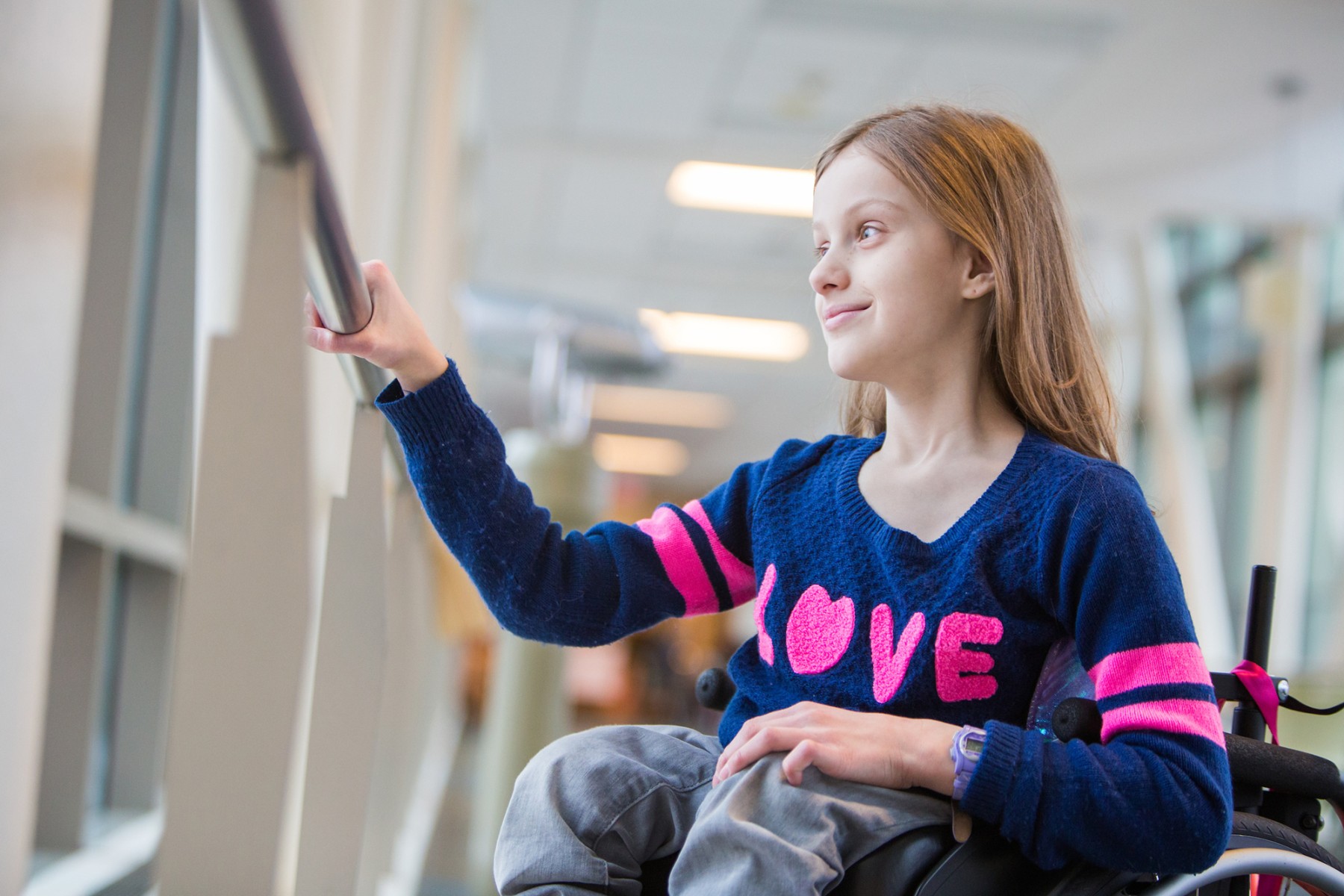What are the signs and symptoms of spina bifida?
Spina bifida can cause paralysis, muscle weakness and sensation issues (including the ability to feel heat, cold and touch). Other symptoms of spina bifida can include:
- Attention and learning disabilities
- Other bone and muscle issues, including scoliosis
- Hydrocephalus
- Latex allergies or sensitivities
- Skin issues (such as pressure ulcers or injuries) resulting from decreased sensation
- Strabismus (sometimes called “lazy eye”)
- Epilepsy and seizures (rarely)
- Weight gain
Children with more severe forms of spina bifida usually require specialty care throughout their lives, including as adults.
Children who have open spina bifida can experience a wide range of related complications, depending on the severity and location of the abnormal spinal cord development. Such complications happen most often in myelomeningocele—one of two main types of spina bifida. The higher up the spine the irregularity occurs, the more severe it is.
Leg muscle weakness or paralysis is one of the most serious symptoms of myelomeningocele, because it leads to many other complications. Children who have myelomeningocele can’t control muscles below the affected area of the spine. Their skin is also less sensitive than in people who don’t have this condition.
Because the lowest part of the spinal cord controls bowel and bladder function, difficulties controlling these functions are very common, but can be managed.
How is spina bifida diagnosed?
A variety of tests can help to diagnose and manage spina bifida. A diagnosis is often confirmed following screening tests during pregnancy using prenatal imaging with ultrasound or MRI. Radiology and imaging tests used to help make a diagnosis, include:
- MRI: This test uses a powerful magnetic field and radio signals to create detailed pictures of structures in the body. Such structures include the brain, spinal cord, joints (including the joints of the spine itself).
- Ultrasound: Ultrasonography uses high-frequency sound waves to outline structures in the body. Urologists also use ultrasound to view the kidneys and bladder.
- CT scan: A CT scan uses X-rays to make detailed pictures of structures inside the body. Doctors use CT scans of the head to check the size of the brain’s cavities (ventricles). If the ventricles are enlarged, your child might have hydrocephalus.
- Cystometrogram/urodynamics: These tests help doctors see how well the bladder stores and releases urine. Tests involve filling the bladder with normal saline. Then, machines record the pressure inside the bladder and the activity of the pelvis muscles.
- Voiding cystourethrogram: This X-ray of the bladder lets doctors rule out urine backing up into the kidneys (also known as reflux). Before taking the X-ray, the health care provider uses a catheter to fill the bladder with a solution (such as barium or iodine) that makes it easier to see.
- X-ray: X-rays of the head, spine, arms and legs can help health care providers monitor changes during growth and identify potential problems.
- Manual muscle testing: Physical and occupational therapists perform manual muscle tests. They use a graded scale to rate strength and check for muscle weakness. Repeating the tests yearly helps detect changes.
- Neuropsychological evaluations: A neuropsychological evaluation can give important information about common cognitive difficulties such as problems with attention, memory, learning, and problem-solving.
At Gillette Children’s, we also offer prenatal consultations. During the consultation we can share information about the signs of spina bifida and what’s involved in doing spina bifida tests.
How is spina bifida treated?
Because spina bifida affects many areas of the body, Gillette brings together an extensive team of internationally recognized experts to care for your child.
The following are the most common types of spina bifida treatment.
If your infant has spina bifida, surgery is usually recommended within 24 to 48 hours of birth. A neurosurgeon removes the sac that contains the atypically formed spinal cord pushing out from the opening in the spinal column. Then, the neurosurgeon places the spinal cord in as normal a position as possible.
The spina bifida repair procedure protects any functioning nerve tissue around the spinal cord from injury and infection.
Surgical repair of the other forms of spina bifida is less urgent and is often done after the newborn period.
In addition to repairing the opening in the spine, Gillette neurosurgeons manage other conditions related to spina bifida, such as hydrocephalus and tethered spinal cord. Orthopedic surgeons can address conditions that might accompany spina bifida, such as foot deformities, dislocated hips, fractures, bowlegs, or scoliosis.
Based on your child’s condition and symptoms, you might work with a medical care team that also includes urologists, neurologists, rehabilitation medicine specialists, sleep specialists, and dieticians.
Some children, teens, or adults might also need equipment such as wheelchairs, seating systems, walkers, and braces (also known as orthoses). Our therapists work with Orthotics, Prosthetics, and Seating practitioners to find the right equipment for your child.
If your child has spina bifida, Gillette rehabilitation medicine physicians will collaborate with therapists to create treatment plans to promote your child’s mobility and independence. Gillette offers a full range of rehabilitation therapy services, including physical, occupational, and speech therapy programs designed especially for people who have spina bifida.
Coordinating medical care, mental health issues, and adjusting to life with a complex condition can be hard on families. Gillette offers a variety of services from social workers, child life specialists, psychologists, neuropsychologists, chaplains, therapeutic recreation specialists, and more. Our transition services also support teens and families in making the transition to adulthood and adult-focused health care.
For conditions that continue into adulthood—like spina bifida—we offer services through the Gillette Adult Services Clinic for older teens and adults. Experts here and at our Adult Inpatient Unit specialize in spina bifida and its age-related effects.
 Home Page
Home Page

